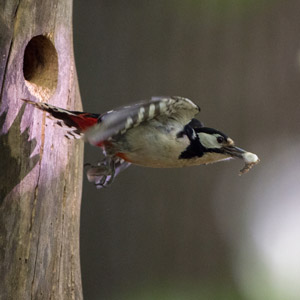Pratique | Débuter
Les sacs fécaux, les « couches culottes » des oisillons

Pic épeiche (Dendrocopos major) emportant le sac fécal d’un de ses oisillons en dehors de la cavité de nidification, Belgique, le 19/05/2016.Photographie : Marc Fasol
Introduction
Le nettoyage du nid est un comportement répandu mais peu étudié chez les oiseaux. Les parents retirent les coquilles brisées, les œufs non éclos, les oisillons morts, les objets étrangers (y compris parfois les bagues !) et les sacs fécaux. Ces derniers sont des poches de mucus blanchâtres qui contiennent les déjections des oisillons de plusieurs espèces, essentiellement des passereaux et des pics. Les parents les récupèrent, les transportent sur plusieurs mètres puis les jettent, ou même parfois les mangent. On ne connaît pas encore avec certitude les objectifs de ce comportement : il pourrait permettre de maintenir l’hygiène du nid pour éviter les risques de maladies et de parasitage et/ou éviter d’attirer l’attention des prédateurs (odeurs, traces). Après une présentation des sacs fécaux (définition, production et élimination), nous recensons leurs fonctions possibles.
Abstract
Nest sanitation is a widespread but little studied birds behavior. Parents remove the broken shells, unhatched eggs, dead chicks, foreign objects (including sometimes rings!) and fecal sacs. These are a mucous membrane, generally white or clear with a dark end, that surrounds the feces of some species of nestling birds. They are produced mainly by songbirds and woodpeckers nestlings. Parents remove and transport them several meters away from the nest and then throw them, or sometimes even eat them. It is not yet known the goals of this behavior: it could maintain the hygiene of the nest to avoid the risk of disease and parasitism and/or avoid attracting predators. After a presentation of fecal sacs (definition, production and elimination), we identify their possible functions.
Poursuivez la lecture de cet article, en vous abonnant dès maintenant !
Découvrez les Archives d’Ornithomedia.com
Pour seulement 10,00 €TTC/an (ou 6,00 € les 6 mois)
Profitez de plusieurs centaines d’articles en accès illimité et sans aucun engagement.
Compléments
À lire aussi sur Ornithomedia.com
- Certains oiseaux utilisent leurs connaissances en botanique pour construire leur nid
- La disparition de certains oiseaux entraîne celle de leurs poux spécifiques
- Pourquoi les Vautours indiens ont-ils peu de poux ?
Sources
- Juan Diego Ibáñez-Álamo, Francisco Ruiz-Raya, Laura Rodríguez et Manuel Soler (2016). Fecal sacs attract insects to the nest and provoke an activation of the immune system of nestlings. Frontiers in Zoology. Volume 13. Numéro 3. http://frontiersinzoology.biomedcentral.com/articles/10.1186/s12983-016-0135-3
- Juan Diego Ibáñez-Álamo, Francisco Ruiz-Raya, Gianluca Roncalli et Manuel Soler (2014). Is nest predation an important selective pressure determining fecal sac removal? The effect of olfactory cues. Journal of Ornithology. Volume : 155. Numéro : 2. Pages : 491-496. Avril. http://rd.springer.com/article/10.1007/s10336-013-1031-7
- Nathalie Santa Maria (2014). Couche culotte ou sac fécal ches les Rougequeues noirs. Birdwatching and Photography. Date : 24/07. http://bioclicetphotos.blogspot.fr/2014/07/couche-culotte-ou-sac-fecal-ches-les.html
- American Robin. Disposable Diapers for Birds. https://www.learner.org/jnorth/tm/robin/FecalSacs.html
- Sialis. Removing Fecal Sacs. www.sialis.org/fecalsacs.htm
- Juan Diego Ibáñez-Álamo, Magdalena Ruiz-Rodríguez et Juan José Soler (2014). The mucous covering of fecal sacs prevents birds from infection with enteric bacteria. Journal of Avian Biology. Volume 45. Numéro 4. Pages : 354–358, July 2014http://onlinelibrary.wiley.com
- Juan D. Ibáñez-Álamo, Olivia Sanllorente, Laura Arco et Manuel Soler (2013). Does Nest Predation Risk Induce Parent Birds to Eat Nestlings’ Fecal Sacs? An Experimental Study. Annales Zoologici Fennici. Volume : 50. Numéros 1-2. Pages : 71-78. www.bioone.org/doi/abs/10.5735/086.050.0106
- Paula K. Kleintjes et Donald L. Dahlsten (1992). A Comparison of Three Techniques for Analyzing the Arthropod Diet of Plain Titmouse and Chestnut-Backed Chickadee Nestlings. Journal of Field Ornithology. Volume 63. Numéro 3. Pages : 276-285. www.jstor.org
- Wikipedia. Fecal sac. https://en.wikipedia.org/wiki/Fecal_sac#cite_note-11
- Mélanie F. Guigueno et Spencer G. Sealy (2012). Nest sanitation in passerine birds: implications for egg rejection in hosts of brood parasites. Journal of Ornithology. Volume : 153. Numéro : 1. Pages : 35-52. Janvier. http://rd.springer.com/article/10.1007/s10336-011-0731-0 Laurie Stuart Simons et Lee H. Simons (1993). Seed Dispersal through Removal of Avian Nestling Fecal Sacs. The Southwestern Naturalist. Volume 38. Numéro 3. Pages : 282-284. www.jstor.org
- Martin L. Moron (1979). Fecal sac ingestion in the mountain White-Crowned Sparrow. Condor. Volume 81. Pages : 72-77. https://sora.unm.edu/sites/default/files/journals/condor/v081n01/p0072-p0077.pdf
- Jason D. Lang, Carrie A. Straight, and Patricia Adair Gowaty (2002) Observations of fecal sacs disposal by Eastern Bluebirds. The Condor. Volume : 104. Numéro : 1. Pages : 205-207. http://www.aoucospubs.org
- Jenny E. McKay, Michael T. Murphy, Sarah Bartos Smith et Jennifer K. Richardson (2009) Fecal-Sac Ingestion by Spotted Towhees. The Condor. Volume : 111. Numéro : 3. Pages : 503-510. www.aoucospubs.org/doi/abs/10.1525/cond.2009.080065




 1 commentaire
1 commentaire
1 commentaire(s) sur ce sujet
Participer à la discussion !Abdelazize Franck BOUGAHAM
Souk El Tenine
Posté le 20 août 2018
Oui, de même pour la Sitelle kabyle Sitta ledanti qui récupère à chaque fois les sacs fécaux des ses bébés oisillons, même parfois; à l’âge avancé des oisillons participe eux même au nettoyage du nid où ils donnent leurs sacs fécaux aux parents.
Pour plus de détails voir l’article publié dans la revue alauda par Abdelazize Franck BOUGAHAM, Adouda BENAZOUZ & Abdelouhab BOUCHAREB.
Titre: Reproduction et soins parentaux chez la Sitelle kabyle Sitta ledenti dans la forêt de Guerrouche (Jijel, Algérie), 2017.